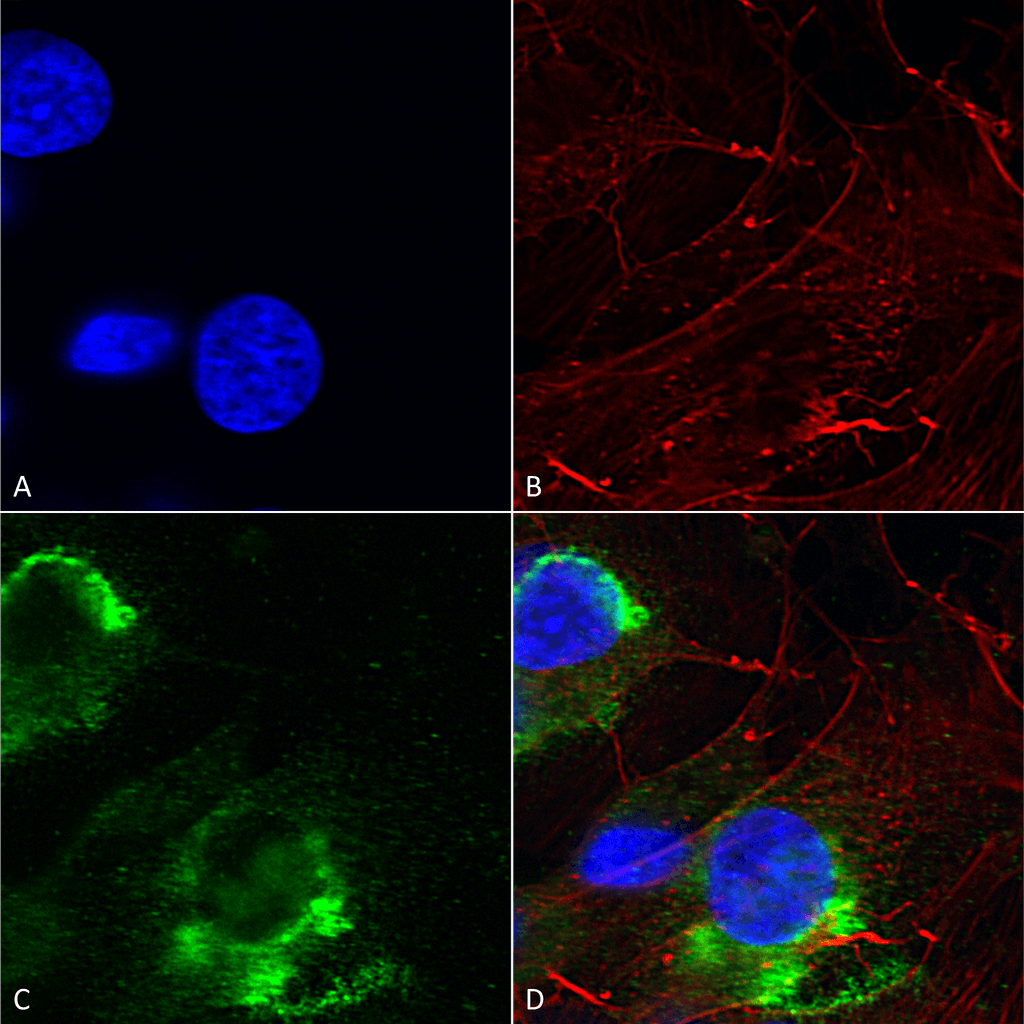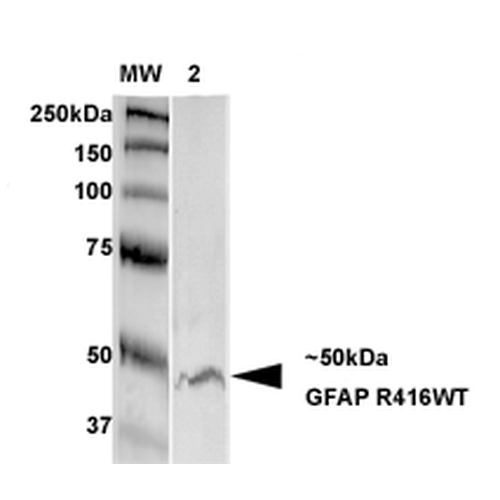GFAP R416WT Antibody
GFAP R416WT Antibody, Clone S206B-9
- SPECIFICATION
- CITATIONS
- PROTOCOLS
- BACKGROUND

Application
| WB, IHC, ICC |
|---|---|
| Primary Accession | P14136 |
| Other Accession | NP_001124491.1 |
| Host | Mouse |
| Isotype | IgG1 |
| Reactivity | Human, Mouse, Rat |
| Clonality | Monoclonal |
| Description | Mouse Anti-Human GFAP R416WT Monoclonal IgG1 |
| Target/Specificity | Detects ~50kDa. Does not cross-react with GFAP-R416W or other proteins (based on KO validation results). |
| Other Names | Glial fibrillary acidic protein Antibody, Intermediate filament protein Antibody, Astrocyte Antibody, gfapl Antibody, DKFZp459C0729 Antibody, MGC139638 Antibody, FLJ45472 Antibody, AI836096 Antibody, GFAP Antibody |
| Clone Names | S206B-9 |
| Immunogen | Synthetic peptide amino acids 411-422 (KTVEMRDGEVIK) of human GFAP; 100% identical in rat and mouse. >50% identity with other proteins (Vimentin, Desmin and Peripherin). |
| Purification | Protein G Purified |
| Storage | -20ºC |
| Storage Buffer | PBS pH 7.4, 50% glycerol, 0.1% sodium azide |
| Shipping Temperature | Blue Ice or 4ºC |
| Certificate of Analysis | 1 µg/ml of SMC-442 was sufficient for detection of GFAP R416WT in 20 µg of rat brain lysate by colorimetric immunoblot analysis using Goat anti-mouse IgG:HRP as the secondary antibody. |
| Cellular Localization | Cytoplasm |

Thousands of laboratories across the world have published research that depended on the performance of antibodies from Abcepta to advance their research. Check out links to articles that cite our products in major peer-reviewed journals, organized by research category.
info@abcepta.com, and receive a free "I Love Antibodies" mug.
Provided below are standard protocols that you may find useful for product applications.
Background
The 50 kDa type III intermediate filament protein glial fibrillary acidic protein (GFAP) is a major structural component of astrocytes. GFAP associates with the calcium binding protein annexin II-p2 and S-100. Association with these proteins together with phosphorylation regulates GFAP polymerization. Astroycytes respond to brain injury by proliferatin (astrogliosis), and one of the first events to occur during astrocyte proiliferation is increased GFAP expression. Interestingly, antibodies to GFAP have been detected in individuals with dementia.
References
1. Velasco M.E., et al. (1980) Cancer. 45:484.
2. Bonnin J.M., et al. (1984) Acta Neuropathology. 62:185.
3. Lee VM-Y., et al. (1984) J. Neurochem. 42:25-32 (1984).
4. Trojanowski JQ et al. (1986) J. Neurochem. 6(3): 650-660 (1986).
5. Schmidt ML et al; Lab Invest 56:282-294 (1987).
6. Kosik KS et al; Neuron 1:817-825 (1988).
7. Schmidt ML et al; Lab Invest 59:460-466 (1988).
8. Mokuna, K, et al: J Neurosci Res 23:396 (1989).
9. Molenaar, et al; Exp Neurology 108:1-9 (1990).
10. Tohyama T et al; Am J Pathol, 142:871-882 (1993).
11. Tohyama T et al; Am J Pathol 142:883-892 (1993).
12. Thilenius, A.R.B., et al; J. Immunol. 162(2): 643-650 (1999).
If you have used an Abcepta product and would like to share how it has performed, please click on the "Submit Review" button and provide the requested information. Our staff will examine and post your review and contact you if needed.
If you have any additional inquiries please email technical services at tech@abcepta.com.













 Foundational characteristics of cancer include proliferation, angiogenesis, migration, evasion of apoptosis, and cellular immortality. Find key markers for these cellular processes and antibodies to detect them.
Foundational characteristics of cancer include proliferation, angiogenesis, migration, evasion of apoptosis, and cellular immortality. Find key markers for these cellular processes and antibodies to detect them. The SUMOplot™ Analysis Program predicts and scores sumoylation sites in your protein. SUMOylation is a post-translational modification involved in various cellular processes, such as nuclear-cytosolic transport, transcriptional regulation, apoptosis, protein stability, response to stress, and progression through the cell cycle.
The SUMOplot™ Analysis Program predicts and scores sumoylation sites in your protein. SUMOylation is a post-translational modification involved in various cellular processes, such as nuclear-cytosolic transport, transcriptional regulation, apoptosis, protein stability, response to stress, and progression through the cell cycle. The Autophagy Receptor Motif Plotter predicts and scores autophagy receptor binding sites in your protein. Identifying proteins connected to this pathway is critical to understanding the role of autophagy in physiological as well as pathological processes such as development, differentiation, neurodegenerative diseases, stress, infection, and cancer.
The Autophagy Receptor Motif Plotter predicts and scores autophagy receptor binding sites in your protein. Identifying proteins connected to this pathway is critical to understanding the role of autophagy in physiological as well as pathological processes such as development, differentiation, neurodegenerative diseases, stress, infection, and cancer.



